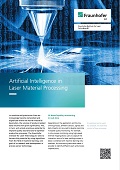Depending on the application and the machining process, different sensors, signals and data streams can be used to develop real-time AI-based quality monitoring. For example, in-situ process monitoring using high-speed thermal imaging allows users to capture the interaction zone of a laser welding process in detail. Combined with machine learning (ML) methods, this monitoring technique makes it possible to identify different seam and process imperfections.
To advance application-specific AI solutions, the experts at Fraunhofer ILT have developed their own software module. Among other things, this tool enables them to calculate and evaluate different signal and image features, which are then combined to form an overall process fingerprint. In a further step, the institute can carry out a quality assessment of the process result to generate carefully prepared sample data sets.
Depending on the specific application, different ML algorithms are used to distinguish process imperfections – such as surface pores, seam collapse, lack of connection, spatter and deviations in focal position – on the basis of the specific fingerprint.
In addition to algorithms found in classical machine learning, deep learning approaches such as convolutional neural networks (CNN) are used at Fraunhofer ILT to assess local weld seam quality based on raw image data. This offers great advantages, for it is not only more flexible, but can also scale up the AI solutions since here, for example, complex FPGA implementations of the image processing steps can be omitted. In many cases, such end-to-end solutions can also detect defects significantly better than conventional ML approaches; this way, high detection rates can be achieved along with low false alarm rates. After appropriate runtime optimization, the trained neural networks can be executed on commercially available GPUs at over 1000 frames per second with low latency, making them suitable for real-time quality monitoring in laser material processing.

 Fraunhofer Institute for Laser Technology ILT
Fraunhofer Institute for Laser Technology ILT